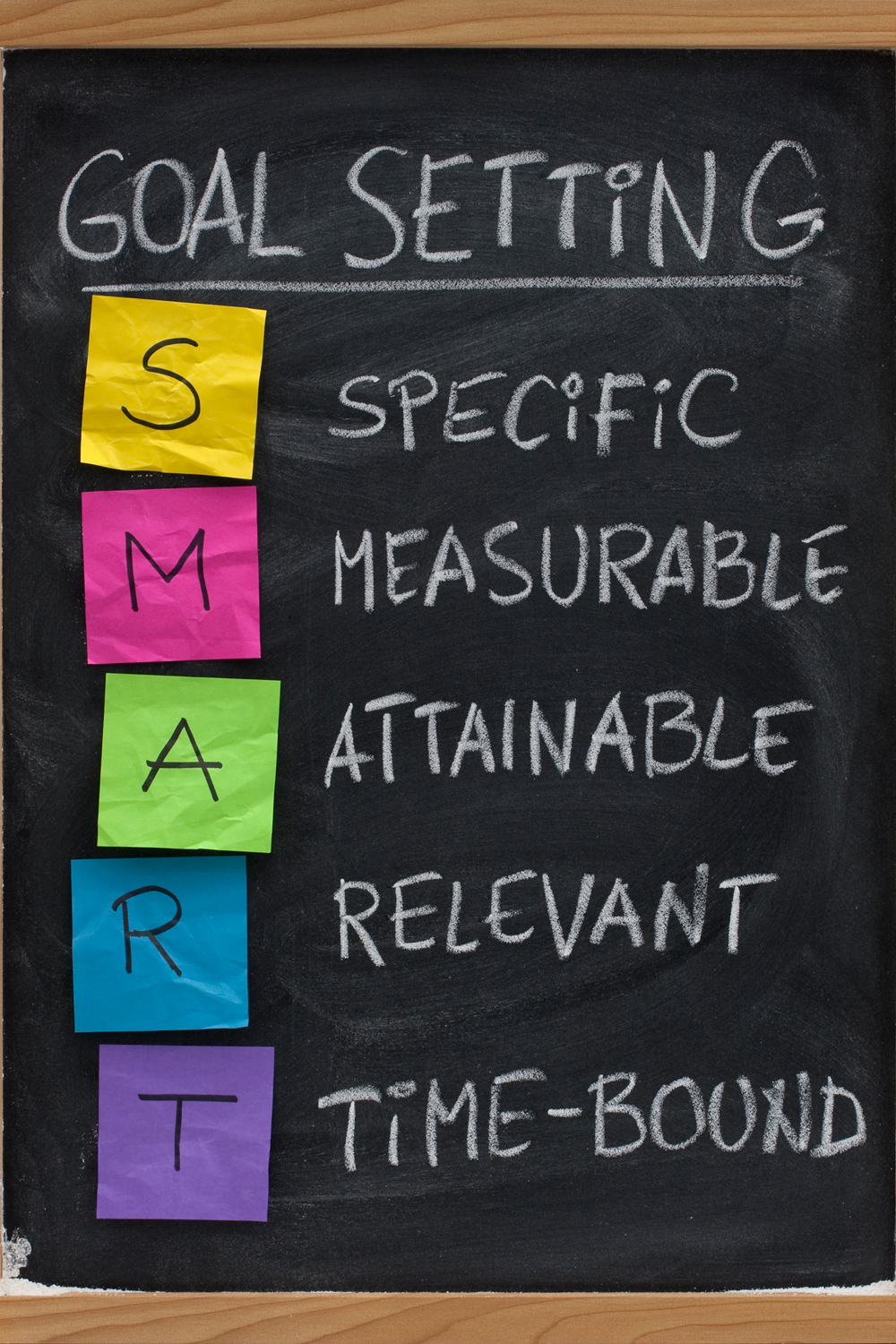Long Term Fitness Goals – Motivate The SMART Way!
Most fitness challenges are short-term: a 30-Day Walking Challenge or a 9-week Couch to 5K plan. And that’s great! But how do you stay motivated and on track with your fitness aims once those challenges come to an end? That’s where long term fitness goals come into play.
Long term goals provide the drive to make big changes to your health and fitness. A long term fitness goal typically lasts 6 to 12 months. That’s long enough for some serious weight loss, to drastically improve at a sport, or get in shape for an exciting adventure. The details are down to you.

Goal Setting
Think of long term goals as a realistic wishlist. For example, it’s realistic to dream of running the London Marathon. It’s not realistic to dream of winning it unless you’re already a pro athlete or a young talented runner with a strong work ethic and a long time frame.
Work with what you have in terms of current fitness and ability. Think about what could you possibly achieve in 6 to 12 months with a good exercise program, healthy habits, and the right attitude.
Adjust your plans for personality and motivation levels. Some people may be happy to live a monk-like existence fully dedicated to their fitness routine.
Others still have a social life and just want to lose a few pounds and be a little bit fitter.
There’s no right or wrong answer. Attainable goals come from following a consistent workout routine and making sustainable nutrition changes. Set the bar too high and you’re setting yourself up for failure. Too low and you’ll lose interest because it won’t be enough of a challenge.

What Are Examples Of Long Term Fitness Goals?
The possibilities are endless but these long term goals will be sizeable challenges:
- Lose 20 pounds
- Run a half marathon
- Run a sub-25-minute 5K
- Climb a high mountain
- Complete your first ultra-marathon
- Bench press 200 lbs
- Box jump onto a 24-inch box
- Be able to do the splits
- Complete 50 push-ups with good form.
Read about different types of fitness goals such as body goals, strength-building goals, endurance goals, and flexibility goals in this post about setting realistic fitness goals.

How Do You Set Long Term Fitness Goals?
When you’re setting goals avoid being vague – that just leads to procrastination. Instead of a goal of eating healthy food, make your goal “I’m going to eat my 5-A-Day, quit sugar, lose 10 pounds by walking 3 miles a day, and reduce my blood sugar to normal healthy levels”.
The details of a long term goal are specific to you and you alone. They can be based on a need to be healthier, a desire to be better at a sport, or something you’ve always wanted to do but never thought was possible.
For best results use a fitness plan where you set out your long term goals and break those goals down into intermediate steps.
For example, if your running goal is to complete a marathon in 12 months and you’re a beginner runner, these could be your intermediate goals:
- Run 1 mile without stopping
- Run 5K continuously
- Complete a 10K race
- Run 10 miles continuously
- Complete a half-marathon race
- Run 20 miles continuously
Take your long term aim and work out your fitness journey to get there. If your goal is to lose weight, the main objective is losing body fat. But for other goals, there may be a combination of fitness objectives.
For example, if your long term fitness goal is backpacking along the Appalachian Trail you’ll need trekking training for overall body strength, cardiovascular fitness, and stamina.
Your fitness regimen and training plan would include intermediate goals for strength training, aerobic fitness, and long days of hiking.

Why Most Fitness Goals Fail
The main reason most fitness goals fail isn’t because they’re too vague or too ambitious. It’s because there’s no system to reinforce progress.
I’m sure everyone has set New Year’s resolutions. Every year millions of people pledge to lose weight and get fit.
By the end of January, or even earlier, most people abandon their health and fitness plans. Why? Because there’s no accountability.
The goals may be specific and often they’re relevant and achievable but there’s no systematic measurement of progress.
No feedback to make sure the fitness program is working. No tweaking the workout regimen and monitoring fitness level.
Instead of consistent exercise and slow but steady gains, there’s an all-or-nothing approach. Start a workout program at the beginning of January, start skipping sessions as the enthusiasm wears off, and abandon the program because it’s not working.

SMART Fitness Goals
Setting SMART fitness goals will increase your chance of success. SMART goals are:
- Specific – a clear goal not a vague aim.
- Measurable – it’s only a goal if it’s measurable.
- Attainable – is it something you can achieve in the time allocated?
- Relevant – does it match your inspirations and current fitness level?
- Time-bound – even if it’s a long term goal it still needs a time limit.
Let’s look at the five criteria in detail:
Specific
The more you know about the goal you’re trying to achieve the better. Define it exactly. Instead of “I’m going to run faster” make your goal “I’m going to take 3 minutes off my 5K PB by running 5 times a week and speed training”.
Think about the WHY. What will reaching this goal mean to you? How will you feel?
Hitting goals takes a lot of dedication, especially long term goals. It can be easy enough to stay on track with a short-term 30-day challenge.
It’s a whole different ballpark of effort to keep the momentum going for 6-12 months. You need a strong and very specific goal to keep you moving forward. Something that excites you.

Measurable
There must be a way to measure progress. This could be anything from running times, number of push-ups, distances run or pounds lost.
It doesn’t have to be actual numbers. You could use a relative scale. For example, if you’re measuring flexibility, you could measure improvements to your range of motion when stretching on a scale of 1-10.
Measure progress regularly, at least once a week, and use the feedback to adjust your training. All training plans should be fluid: adjust based on results and progress.
Attainable
Make sure your long term fitness goals are attainable. Don’t set the bar too high or you’ll get discouraged if you don’t reach it.
Be realistic about the time and resources available to you and your level of commitment.
Often the biggest mistakes are made around weight loss. That’s hardly surprising when we’re bombarded by misleading adverts from the diet industry.
Aim for realistic goals. For most people losing weight is a slow and steady process. If you’re losing less than one pound a week but that weight loss is consistent, you’re still making progress. The aim is to lose weight permanently rather than end up yo-yo dieting.
Strive for improved health markers such as lower blood pressure and cholesterol levels instead of drastic, unrealistic weight targets.
Often the best results happen when you take steps to enjoy life more. Take up a new sport, find a walking group, and take part in healthy activities with friends and family.
When you make the journey enjoyable you can expect more long term success.

Relevant
Are your goals relevant to what you want to achieve? Instead of blindly choosing fitness goals such as being able to do 50 press-ups or running 10 miles without stopping, make sure the goals match your aspirations.
If you want to run a faster 5K, being able to run 10 miles continuously isn’t important. Instead, you need to focus on high-intensity interval training, tempo runs, and strength training to run faster.
If you want to be a better rock climber, work on your climbing skills. Training for strength and endurance at the climbing wall will be better than doing press-ups.
Time-bound
To make a goal meaningful it needs a realistic time frame. Even if it’s a long term goal of running a marathon in two years, break the goal down into more achievable intermediate steps and set yourself deadlines for each one.
For example, set the intermediate goal of running 5K continuously within 6 weeks.
Time frames should be relevant to your current fitness level and abilities. If you have realistic expectations and set achievable goals, you’ll stay motivated and enjoy more long term success.
Smart fitness goal examples
A SMART goal for a beginner runner could be: “Within 6 months I’m going to run 5K in 30 minutes by running three times a week.”
You could measure progress with a weekly timed 5K run and set intermediate goals such as running sub 35 minutes within one month, sub 32 minutes within 3 months, etc.

How To Make A SMART Fitness Goal SMARTER
You can extend the criteria for SMART goals to SMARTER by adding two extra criteria. You may come across different definitions of the E and R but I prefer Evaluate and Reward.
It adds to my view that feedback is essential to setting good SMART goals.
Evaluate
This means assessing how well you’re progressing towards your goal. In your fitness journal evaluate what’s going well and what needs to be improved.
Make changes to your plan if you’re not making progress or if your progress is too slow.
Reward
Set yourself rewards for achieving your intermediate goals and long term fitness goals. This could be a physical reward such as new running shoes or a non-physical reward such as a massage or an afternoon off. The bigger the goal, the bigger the reward.
The reward doesn’t have to cost money, it could simply be time off from your regular fitness activities. Celebrate successes and use the rewards as motivation to continue training hard and reaching goals.
Do You Need A Personal Trainer?
A personal trainer can help you put together a solid exercise program based on SMART goals. It isn’t essential to have a personal trainer and some people prefer to work without one.
A trainer can help with setting up your workout plan, keeping you motivated, and working towards your long term fitness goals.
Thoughts From Love Life Be Fit
Goal setting with long term fitness goals is important for making progress and getting the results you want from your training. Making sure they’re SMART fitness goals will ensure you get the most from your efforts.
Take some time to set your SMART goals and use them to make a plan for success. Keep evaluating results, adjust based on progress, and reward yourself for successes along the way.
Most importantly enjoy your training and have fun reaching those goals!








